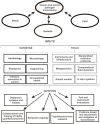Bioaerosols and Transmission, a Diverse and Growing Community of Practice
- PMID: 30847337
- PMCID: PMC6394210
- DOI: 10.3389/fpubh.2019.00023
Bioaerosols and Transmission, a Diverse and Growing Community of Practice
Abstract
The transmission of infectious microbes via bioaerosols is of significant concern for both human and animal health. However, gaps in our understanding of respiratory pathogen transmission and methodological heterogeneity persist. New developments have enabled progress in this domain, and one of the major turning points has been the recognition that cross-disciplinary collaborations across spheres of human and animal health, microbiology, biophysics, engineering, aerobiology, infection control, public health, occupational health, and industrial hygiene are essential. Collaborative initiatives support advances in topics such as bioaerosol behavior, dispersion models, risk assessment, risk/exposure effects, and mitigation strategies in clinical, experimental, agricultural, and other field settings. There is a need to enhance the knowledge translation for researchers, stakeholders, and private partners to support a growing network of individuals and agencies to achieve common goals to mitigate inter- and intra-species pathogen transmission via bioaerosols.
Keywords: CANIBAN; bioaerosols; collaborations; infections; microbes; network; viral dissemination; virus.
Figures
References
-
- Yassi A, Moore D, Fitzgerald JM, Bigelow P, Hon CY, Bryce E, et al. . Research gaps in protecting healthcare workers from SARS and other respiratory pathogens: an interdisciplinary, multi-stakeholder, evidence-based approach. J Occup Environ Med. (2005) 47:41–50. 10.1097/01.jom.0000150207.18085.41 - DOI - PMC - PubMed
Publication types
Grants and funding
LinkOut - more resources
Full Text Sources


